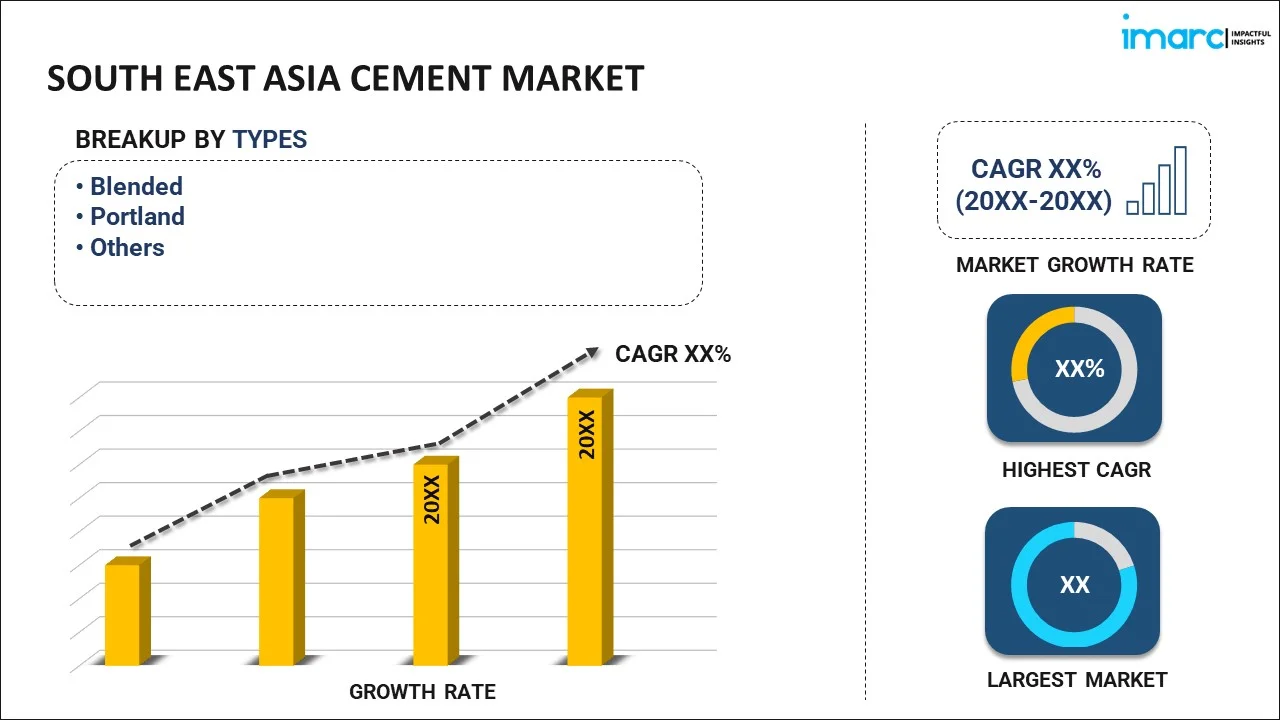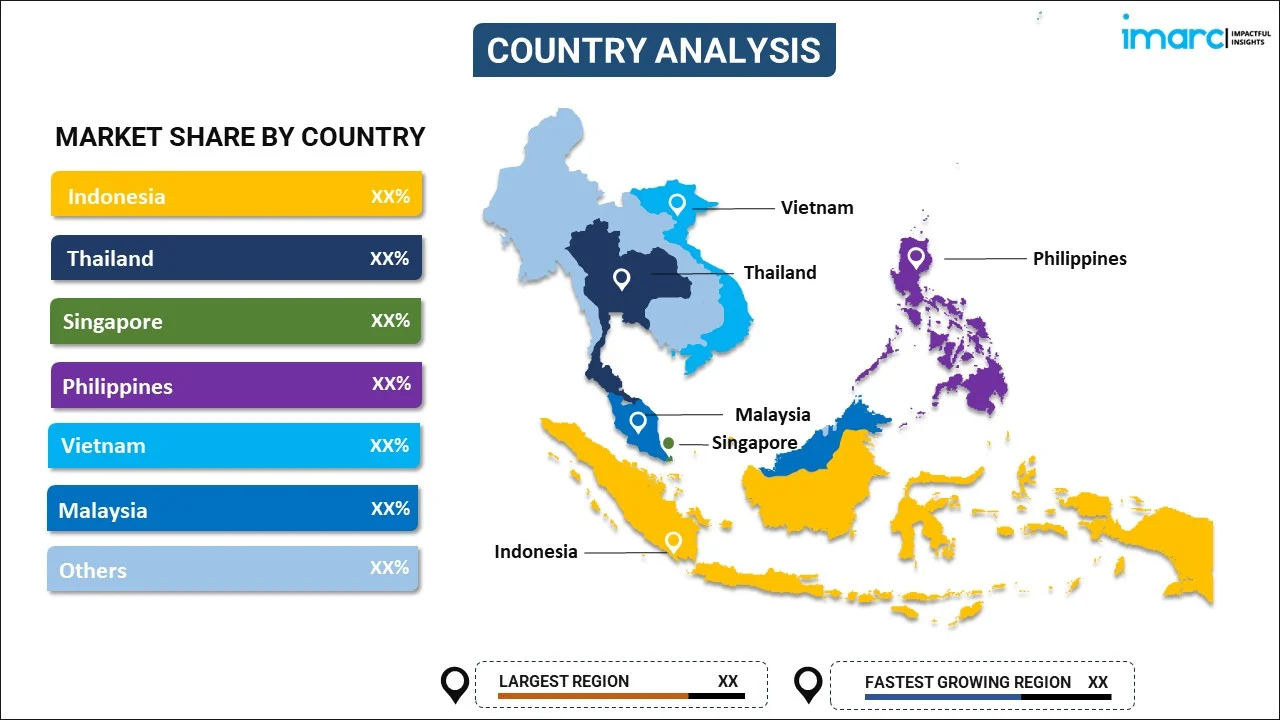
South East Asia Cement Market Report by Type (Blended, Portland, and Others), End Use (Residential, Commercial, Infrastructure), and Country 2024-2032
Market Overview:
South East Asia cement market size is projected to exhibit a growth rate (CAGR) of 7.63% during 2024-2032. The growing construction of residential and commercial buildings, increasing shift towards green building practices and eco-friendly construction materials, and technological advancements in manufacturing processes represent some of the key factors driving the market.
|
Report Attribute
|
Key Statistics
|
|---|---|
|
Base Year
|
2023 |
|
Forecast Years
|
2024-2032
|
|
Historical Years
|
2018-2023
|
| Market Growth Rate (2024-2032) | 7.63% |
Cement is a finely ground powdery substance that forms a paste when mixed with water and hardens as it dries. It is available as Portland cement, rapid hardening cement, white cement, and low-heat cement. It is primarily manufactured by heating a mixture of limestone and clay to a high temperature and then converting it into a fine powder. It provides high compressive strength to the structures and withstands environmental elements and chemical attacks. It is pliable when mixed with water, allowing for easy shaping and molding. It is crucial in the construction industry due to its strength and versatility. It is the backbone of modern infrastructure, providing the necessary foundation for buildings and roads. It offers adaptability, which allows for the construction of several types of structures, ranging from small homes to large skyscrapers. It is non-combustible and offers fire resistance. It is used in decorative and architectural applications, providing aesthetic appeal to structures. It is also employed for waterproofing and sealing against moisture in structures.
South East Asia Cement Market Trends:
At present, the increasing construction of various residential and commercial buildings represent one of the vital factors impelling the market growth in South East Asia. The urban growth and modernization of cities necessitates extensive infrastructure development,. Besides this, government policies and investments in the renovation and remodeling of infrastructure are contributing to the market growth. Regulatory bodies are also initiating substantial infrastructure projects, including smart city projects, improved transportation networks, and affordable housing schemes. In addition, the growing shift towards green building practices and eco-friendly construction materials is positively influencing the market in the region. The increasing demand for blended cement, which reduces the carbon footprint by partially replacing the clinker content with other materials is offering a favorable market outlook. Moreover, the development and adoption of alternative, eco-friendly cement types that offer similar strength and durability are gaining traction. Apart from this, technological advancements in manufacturing processes of cement to enhance efficiency, reduce labor costs, and increase output is propelling the market growth. The development of new formulations and types of cement for specific applications, such as high-performance concrete for extreme conditions, is supporting the market growth. Additionally, the rising need for affordable housing, especially in densely populated cities, is strengthening the market growth. The increasing focus on more sustainable production methods presents opportunities for innovation in the sector. The adoption of more efficient manufacturing processes driven by environmental concerns is bolstering the market growth in the region.
South East Asia Cement Market Segmentation:
IMARC Group provides an analysis of the key trends in each segment of the market, along with forecasts at the regional and country levels for 2024-2032. Our report has categorized the market based on type and end use.
Type Insights:

- Blended
- Portland
- Others
The report has provided a detailed breakup and analysis of the market based on the type. This includes blended, portland, and others.
End Use Insights:
- Residential
- Commercial
- Infrastructure
A detailed breakup and analysis of the market based on the end use have also been provided in the report. This includes residential, commercial, and infrastructure.
Country Insights:

- Indonesia
- Thailand
- Singapore
- Philippines
- Vietnam
- Malaysia
- Others
The report has also provided a comprehensive analysis of all the major regional markets, which include Indonesia, Thailand, Singapore, Philippines, Vietnam, Malaysia, and Others.
Competitive Landscape:
The market research report has also provided a comprehensive analysis of the competitive landscape. Competitive analysis such as market structure, key player positioning, top winning strategies, competitive dashboard, and company evaluation quadrant has been covered in the report. Also, detailed profiles of all major companies have been provided. Some of the key players include:
- Anhui Conch Group Co. Ltd.
- Eagle Cement Corporation
- Hume Cement Industries Berhad
- Tasek Corporation Berhad
- The Siam Cement Group Public Company Limited
(Please note that this is only a partial list of the key players, and the complete list is provided in the report.)
South East Asia Cement Market Report Coverage:
| Report Features | Details |
|---|---|
| Base Year of the Analysis | 2023 |
| Historical Period | 2018-2023 |
| Forecast Period | 2024-2032 |
| Units | US$ Million |
| Scope of the Report | Exploration of Historical and Forecast Trends, Industry Catalysts and Challenges, Segment-Wise Historical and Predictive Market Assessment:
|
| Types Covered | Blended, Portland, Others |
| End Uses Covered | Residential, Commercial, Infrastructure |
| Countries Covered | Indonesia, Thailand, Singapore, Philippines, Vietnam, Malaysia, Others |
| Companies Covered | Anhui Conch Group Co. Ltd., Eagle Cement Corporation, Hume Cement Industries Berhad, Tasek Corporation Berhad, The Siam Cement Group Public Company Limited, etc. (Please note that this is only a partial list of the key players, and the complete list is provided in the report.) |
| Customization Scope | 10% Free Customization |
| Report Price and Purchase Option | Single User License: US$ 3699 Five User License: US$ 4699 Corporate License: US$ 5699 |
| Post-Sale Analyst Support | 10-12 Weeks |
| Delivery Format | PDF and Excel through Email (We can also provide the editable version of the report in PPT/Word format on special request) |
Key Questions Answered in This Report:
- How has the South East Asia cement market performed so far and how will it perform in the coming years?
- What has been the impact of COVID-19 on the South East Asia cement market?
- What is the breakup of the South East Asia cement market on the basis of type?
- What is the breakup of the South East Asia cement market on the basis of end use?
- What are the various stages in the value chain of the South East Asia cement market?
- What are the key driving factors and challenges in the South East Asia cement?
- What is the structure of the South East Asia cement market and who are the key players?
- What is the degree of competition in the South East Asia cement market?
Key Benefits for Stakeholders:
- IMARC’s industry report offers a comprehensive quantitative analysis of various market segments, historical and current market trends, market forecasts, and dynamics of the South East Asia cement market from 2018-2032.
- The research report provides the latest information on the market drivers, challenges, and opportunities in the South East Asia cement market.
- Porter's five forces analysis assist stakeholders in assessing the impact of new entrants, competitive rivalry, supplier power, buyer power, and the threat of substitution. It helps stakeholders to analyze the level of competition within the South East Asia cement industry and its attractiveness.
- Competitive landscape allows stakeholders to understand their competitive environment and provides an insight into the current positions of key players in the market.
Need more help?
- Speak to our experienced analysts for insights on the current market scenarios.
- Include additional segments and countries to customize the report as per your requirement.
- Gain an unparalleled competitive advantage in your domain by understanding how to utilize the report and positively impacting your operations and revenue.
- For further assistance, please connect with our analysts.
 Inquire Before Buying
Inquire Before Buying
 Speak to an Analyst
Speak to an Analyst
 Request Brochure
Request Brochure
 Request Customization
Request Customization




.webp)




.webp)












